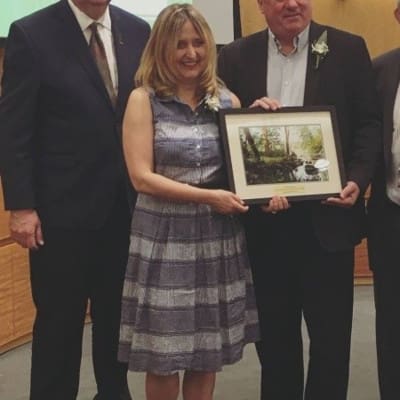Grassroots advocates have the power to mobilize communities and influence policies to improve animal well-being.
In this month’s episode of The Informed Animal Ally, two grassroots advocates share their experiences and the lessons they’ve learned in calling for change for animals.
Note: This written discussion has been edited for length.

Featured Guest: Barbara La Pointe
Librarian
Barbara has volunteered her time to several animal welfare projects in Canada and the United States since 1998. She is responsible for a national campaign asking Canada’s largest classifieds site to ban the commercial sale of animals on its site. This campaign has gained national media attention and the support of 464,000 individuals, 8 major corporations and 31 animal welfare organizations.

Featured Guest: Tessa Vanderkop
Director, Vancouver Humane Society
Tessa is a Social Purpose Strategist with the United Way Social Purpose Institute where she is helping business to become an engine for good in society. She is also a passionate conservationist and led the Ivory-Free Canada campaign with Elephanatics, which received support from more than 700,000 Canadians.
Becoming an animal advocate

Amy: To start us off, I’d love to hear more about how you both became interested in animal advocacy.
How Barbara began advocating for companion animals
Barbara: I lived in the U. S. for seven years. And when I came back to Quebec in a small town located on the island of Montreal, I was floored to see that puppies and kittens were still being sold at the pet store at my local shopping center. So I wanted to change things.
That’s where it started for me.
How Tessa began advocating for elephants and wildlife
Tessa: I think I was born an animal lover. I mean, even as a kid, I had all my little stuffed animals and I would build veterinarians for them and get my mom’s tea cozies and cover them up and say goodnight every night to them.
So I think it was just the way I was born.
And then I was at work in Toronto and I was at the Toronto Convention Centre and one of the publishers at that time had decided to rent an elephant for a campaign. And this elephant was in this convention centre. When I still think about it, I get quite emotional.
I just remember looking at it and thinking, what the heck is going on here? It was just such a disconnect for me. And then it took me probably a few years to do something with that initial thing.
And then I found out that a circus was coming to Canada. And I remember at that time thinking, well, I know how to write. I know how to do publicity, so I’m just going to create as much trouble for the circus as I possibly can. And that’s what I did.
I just chased the circus across Canada and I would send press releases and information to town councils and the mayor. I’d alert local TV and media. And I’d try and reach out to local advocacy groups.
And that was sort of the beginning of connecting a passion with skills that I thought I had.
Amy: That’s so lovely. What a great start to advocacy, but challenging things to have to deal with.
Campaigning for animals

Amy: We heard both of your backgrounds at the beginning of the episode, but I’d like to ask each of you to speak a little bit more about the campaigns you’ve worked on, provide more details, maybe some challenges and successes.
Barbara’s campaigns for companion animals
Barbara: When my local shopping center was still selling cats and dogsat the pet store, I started to attend every council town council meeting in 2012. Every month I went to encourage my city to adopt a bylaw requiring that dogs and cats and rabbits sold in pet store to be sterilized and be sourced from animal shelters.
So I started in 2012 and the bylaw was finally adopted in 2015. So I had started to learn to be patient at that time.
And it’s during those town council meetings that several town councilors kept coming back with the argument that we could not adopt such a bylaw for pet stores or combat pet overpopulation as breeders will still continue to sell animals online on classified sites.
Advocating to stop pet sales on Kijiji
Barbara: So in the summer of 2013, I decided to research the topic and the problems associated with the sale of animals on Kijiji, Canada’s most popular classified site. And I launched a campaign, so it’s been over 10 years now with Kijiji.
The problem that I found was that classified sites were unable to distinguish responsible breeders from breeders who, without regard for animal welfare and the buyer, profit from the sale of animals.
So over the past 10 years, I’ve collected numerous media stories of sick puppies and kittens sold on Kijiji. I gathered testimonials from disappointed Kijiji users, the comments from veterinarians and animal shelters to demonstrate that yes, there are too many buyers that continue to be cheated by unscrupulous and unethical breeders on classified sites like Kijiji.
Too many animals suffering from health problems, often due to rearing and breeding conditions, are sold on this site. That leads to veterinary costs to new guardians and inflicts them with unnecessary emotional and financial stress.
So that’s what me and 465,000 individuals who signed this petition want; we want the leader of Canada’s classified site, Kijiji, to set an example. Animals should not be sold on this site.
Puppy meals and unethical breeders may continue to exist, even if Kijiji Canada stops the sale of animals, but at least they will not give them an easy platform to thrive on. So that’s the goal of this campaign.
Chantelle: That’s such an important message, especially when we’re seeing so much overpopulation and overcrowding in the shelter and rescue system.
There’s so many animals out there who need homes.
Tessa’s advocacy for wildlife
Amy: Tessa, can you share more about the background of the campaign that you’ve been working on?
Tessa: Yeah, for sure. After chasing the circus around for a couple of years, I woke up one morning and I’d heard about a group called the Global March for Elephants and Rhinos.
They were based out of the United States and they organized kind of a global awareness day about the threats facing wildlife in Africa, so elephants and lions and rhinos and so forth. It was a call to action to organize an event. And so I woke up and was like, I’m going to organize an event.
I just Googled elephant advocacy Vancouver. And I found Fran Duthie, who is the founder of Elephanatics. We joined forces and we organized, along with Leanne Fogarty, a number of those annual marches.
And then it was only after the last one where I think we were like, okay, so this is great. We have people coming out to these, but what are we really doing?
And so that’s when we switched tactics. And we really looked at how Canada was enabling the sale of ivory and what that was doing and rhino horn.
Stopping the import of ivory and rhino horn in Canada
Tessa: We pivoted our advocacy towards getting the government to change the actual regulations around importing elephant ivory and rhino horn.
We started with a letter to then-minister Catherine McKenna and it was actually Marylee Davies who said, well, maybe you could get a couple of signatures from other like-minded organizations.
So she gave me some names of some people. We added those names to the letter, but then my colleagues, Fran and Leanne just kind of went crazy. It’s like, well, if we can get three signatures, why can’t we get more? We got a hundred signatures for that letter globally.
So for every letter we wrote, we had this activated network that was willing to support what we were looking for.
And later on, that ended up being quite helpful.
Fran had started our Facebook page. She went out and learned everything about social media. We have 20,000 followers on the Elephanatics Facebook page.
And then Leanne said, well, why don’t we do a petition? And we’re like, yeah, okay, let’s do the petition. We’ll probably get like a hundred signatures, like a thousand signatures.
And that’s when we really started understanding that Canadians did not want, and did not know that we still allowed the legal trade of ivory. So we ended up getting like a thousand signatures, easily, 10,000, and then 20,000, we were like, holy smokes, what is going on?
And that’s when it just kept growing. That Change.org petition is over 700,000 now.
And so that’s not the end of the campaign. We ended up collaborating with other organizations, but that was definitely when we knew we were zeroing in on something.
Chantelle: Wow, that is so impressive. I think it’s so inspiring that it just takes that first spark of identifying that there’s something wrong and just look how much you can accomplish.
Successes in grassroots animal advocacy

Chantelle: I would love to hear more about the successes that you’ve both seen from your work.
Spayed and neutered rescue pets for adoption
Barbara: Yes. With the pet store bylaw, like I said, after three years of campaigning, going to monthly council meetings and writing open letters in the newspapers, asking residents to send an email to counselors, my city finally adopted the bylaw that dogs, cats and rabbits sold in pet stores must be sterilized and be sourced from animal shelters.
We were one of the first cities actually in Quebec to have such bylaw. So that was a great success.
Trap, Neuter, Return, Maintain for community cats
Barbara: Another campaign I worked on is after adopting three stray cats that were roaming in my backyard, I went again to town council meetings asking them this time to implement a Trap, Neuter, Return, Maintain program (TNRM) for community cats.
Again with the help of residents, same thing, same council meetings, open letters and newspapers asking residents to send letters. The program was implemented in 2019 in my small town and is still running today.
It’s fun to see neighbors who still ask me about the program and want to get their permits and stuff like that.
Progress for classified sites
As far as Kijiji, Kijiji today is still selling animals on its site, but I would say that my petition has gathered over 465,000 signatures so far. I see it as a success because it’s 465,000 individuals who are aware of the issue surrounding animals sold on classified sites.
That’s 465,000 individuals who are discussing this matter with a family member, a friend, or a coworker. And that’s 465,000 individuals not buying animals on classified sites.
It’s day by day driving the public discourse to a point where politicians are increasingly compelled to take concrete actions when it comes to the sale of animals on classified sites.
I would like also to add that the classified site Used.ca, based in British Columbia, banned profiting from household pets in 2015. They commented that the Kijiji petition was one of their motivators behind the decision, so this petition is also helping others, other companies, businesses, and individuals to base their decision on, so to me, it’s a success.
Amy: Thanks so much for sharing those. I think something that I end up having a hard time with in advocacy is when you have big goals, seeing all the intermediary steps as successes. It’s so easy to get a feeling of sort of like, Oh, but this one thing hasn’t happened, but it’s so good to see sort of like the process of getting there.
And particularly what Barbara brought up around public attitude change. The only way you’re going to see legal change is when you have really the vast majority of the public on side.
Partnerships in advocacy

Amy: Partnerships play a big role in getting the public on side. Can you speak to the partnerships you’ve made to advance your work for animals?
Tessa: I think it’s so interesting that Barbara, that you use your town council as the muscle for change, because I used to sit on one of the city of Burnaby’s sustainability committee, and it was really always interesting to me that it does make a difference, I think, using those tools as a way of driving change.
Reaching out to the company first
Barbara: For the pet store, I always ask the company first. I went ahead and I wrote a letter to the pet storeabout the problems and when they said no, that’s where I had to go step up somewhere else. That’s why I went to see my town council for that, but always ask communication first with the company.
I did this same thing with Kijiji before I started the petition. I wrote to them just to make sure that they were aware of the problem and there was no action. Then I said, well, I’m going to start a petition. I warned them in advance. I did the same thing at the town council meeting.
I think I’m really believe in open communication with your decision-makers.
Tessa: Yeah, I completely agree. Make friends, not enemies, right? I think is the key and build partnerships as much as you possibly can.
Finding unexpected allies in advocacy
Tessa: I would just add that we had hit a little bit of a roadblock. By this point, we had actually been approached by Humane Society International, Michael Bernard. They had already done a lot of work behind the scenes and had hit a wall, but our petition and our Facebook page and our letters, I think we managed to sort of build that grassroots kind of awareness for the issue.
I had an MP knock at my door and we ended up building a relationship and I educated him quite a bit about what was happening with elephants and the laws in Canada. He was really amazing. He just said, I will do what I can to galvanize some people behind the scenes; and he did exactly that.
One of the things that I’ve learned is you have to be open to talking to everybody because as an advocate, you’re that voice, and that voice and that story needs to be told. Because how else does it happen?
So you’d find me anywhere talking about elephants in the most unusual situations and you find unusual allies in that way.
Chantelle: Those partnerships are so important.
Tessa: Yeah, we would never have been able to do it. The ivory ban has been implemented by the way, it was implemented this January, but we would never have been able to do it without the help.
We worked very collaboratively with Humane Society International, and we had built a larger coalition with some other grassroots organizations, Global March for Elephants and Rhinos Toronto, Heather Craig and Janine Cavin from Elephant and Rhino Defenders, and Patricia Sims from World Elephant Day.
We all worked together, including initially Jane Goodall Canada. So I would say for us as Elephanatics in a grassroots organization, you would never, ever be able to do it. We could have tried it on our own, but, but I think it really takes collaboration.
Chantelle: Absolutely. And that’s so important because everyone who’s advocated for animals knows that there’s so many barriers to persuading decision makers to prioritize compassion for other species. So just having as many voices as possible doing that advocacy work is so important.
Barbara, could you also speak to some of your partnerships that you’ve made in your advocacy work?
Barbara: Of course. At the beginning, it was easy to get 30 animal rescue groups and shelters to sign up for the petitions like Humane Canada, Humane Society International Canada, the BC SPCA, the Winnipeg Humane Society, all those big societies and small shelters and big shelters.
But sometimes you find support in unexpected places.
Over the years, the Kijiji campaign has been endorsed by some of the largest banks, websites and telecommunication providers in the country because they were publishing ads on Kijiji pet sale pages. So I either directly wrote to those companies or I had the help of signers to write to them.
TD Bank, Royal Bank of Canada, Toyota Canada, Tangerine Bank, National Bank of Canada, and TELUS have all pulled their ads off Kijiji pet sale pages in support of this campaign.
So yes, partnership is very important. And then when write to Kijiji, I tell them that, of course, but also tell the government about this. It also helps that it’s not only individuals, but also big companies and more shelters and rescue groups that support this campaign.
Tessa: Yeah. I can’t emphasize that enough, actually. Like you can find support in such unlikely places. Like for example, Mike Farnworth, who is the Minister of Safety, showed up to our marches and would come and support us and buy t-shirts and make donations. You just have no idea who’s an ally and who’s that real believer in wildlife justice and equity.
So I think that’s really key, just being really open minded, even when you feel beleaguered.
Chantelle: Absolutely. That’s absolutely true. We work with people in all sorts of industries in our work, and there’s so many people across so many types of jobs that are really passionate about animals.
Challenges in advocacy

Chantelle: Could you both speak to some of the challenges you faced in your advocacy?
Be flexible
Barbara: Last summer, when I asked Kijiji to have a human moderation team carefully reviewing at all pets ads and ensuring compliance with the policies, they turned me down again.
So I had to look for another solution. So I read and looked back at my campaign material and saw the comment from Used.ca when they banned the profiting from household pets across the entire network. The comment said that websites like ours are not qualified or capable of regulating the breeding of pets.
So it made me think, no one can better regulate pets. I saw this as a challenge.
I contacted every office of the Minister of Agriculture or relevant ministers in each province and territory in Canada to learn about the laws regulating dogs and cat breeders. I discovered that only the provinces of Quebec and New Brunswick require licenses for dog and cat breeders.
So government permits could be the solution to regulating the sale of animals on classified sites. Maybe breeders permits are the way to go. If breeders are issued permits from the government, it may not guarantee that these breeders are conscientious or ethical, but it provides more protection to buyers since these breeders have licenses and can be easily traced. If a problem occurs, it allows for the government to make these breeders responsible and to comply with a certain standard of care, to inspect them or even sanction them, all of which Kijiji and classified sites cannot do.
So yes, when I’m faced with a challenge, don’t despair, go back, look around, be flexible, and maybe you have to change your strategy for the best outcome.
Find another way through
Tessa: Yeah, I completely agree with that. I always think of it as water over rocks; you’ve got to find a way through, one way or the other.
We were dealing with Mr. McKenna’s office and we weren’t getting anywhere. And I think there are times when you just have to realize that it’s just not going to happen in that way. So what else do you do? And in those instances, you know, we would try and find other allies.
So, you know Terry Beech was super helpful in finding allies and then really focusing on the Change.org petition and really raising awareness.
And then also because we were a grassroots organization, when the CITES negotiations would come up, we would really look at how Canada actually voted on all the different issues and report back out publicly on what that looks like.
I think a lot of the public just doesn’t understand how that world works and why would they, right? It’s not everyone’s job to do that, but there is sort of a systemic kind of way of keeping the world working in a “business as usual” way, and we needed to change that. So I think you just find other tactics to say, let’s take this kind of closed world and make it a little bit more open and share with people what this looks like and what they can do.
So that’s when we ended up using New Mode and doing a big MP letter-writing campaign because we’re like, well, we can’t get anywhere with the minister because they don’t care or they don’t have time or there’s some other issues. So let’s just write letters. And so we ended up getting 7,000 letters written to MPs all across the country.
And so then the minister has to respond because the MPs are writing her office saying what’s going on. So I think, like Barbara said, you’ve got to be flexible, you have to be open minded, you can’t be deterred.
Don’t give up
Barbara: I just want to say that don’t be discouraged. I was talking with a friend, she was talking about the podcast her husband was listening to. I listened to the podcast and brought me somewhere else, brought me to a story about credit cards having a policy cutting off adult sites. So I said, you know, why did they do it for the adult sites? Maybe they could also do it for classified sites for animals.
So I contacted all those credit card companies. It didn’t work out. They didn’t budge.
But even though it was a challenge, you always learn something. You know how to write better, how to influence better, negotiate better, every step of the way.
You learn new things outside your topic. But it brings you somewhere else and you go from there.
Know your audience
Tessa: I would completely agree with what Barbara just said. You have to understand a multitude of different audiences.
And so when I first started, I was marching in the streets with signs. I think that’s super necessary on some level, but I think not everyone is going to respond to that kind of advocacy and you have to be willing to learn and change and develop what I would call, and I find it almost offensive, but you know, the business case for why we should not be trading an elephant ivory. You have to be able to talk to people about numbers.
I think when you believe so passionately in something, it’s hard to strip that back and say, okay, well, this is how we have to approach this. But that’s your job is to do that. You’ve got to be dispassionate in your passion.
Barbara: Yeah, I totally agree with you, Tessa. It worked with me with council.
When I brought the numbers, it made a change. It’s sad, but money drives people. Money drives those cities and businesses and so we have to bring it to that level.
Lessons from animal advocates

Amy: I appreciate all the insights that you’re both sharing. It is absolutely step by step; it’s uncovering every little piece of what makes an issue.
These are some great lessons that you’ve learned. Are there any other lessons you’ve learned that you can share from your work?
Storytelling is key
Tessa: I was just thinking about things that helped us. As you say, Amy, if these are all really complex systemic issues, and how do you distill it to something that continues to engage the public and get that support?
And so I think the communications piece and the storytelling piece is so essential, like, how do you tell these stories? How do you continue to bring people along? Because I think it’s a lot to ask the general public to understand the complexities of everything, but what are ways and tools that we can use?
People in our community came up with these really easy to see graphics that told the story very quickly about what was happening to Africa’s elephant population. And so that became very shareable on social media.
And it’s just those kinds of things. How do we go from us to everyone else and what is the best way and the most compelling way and true way to tell the story that can gain traction.
So I’d say that that’s also something to really think about.
Communicate with the decision-makers you’re working to persuade
Barbara: Communication is very important. No matter how frustrating it can be, it can feel like you’re not being listened to, it’s better to partner with the people you want to change.
I’m proud to have open communication with Kijiji. That communication has led to improvements like the credit card verification requirements they did at the beginning in 2014 or 2015.
Official responses from your decision-makers help show that they are engaged and can guide you in choosing a path forward because you can find information on what they say and always keep learning about your petition topic, in and out and outside your topic.
Without that, you wouldn’t learn about new arguments to take to bring onto the table or know if ending pet sales was necessary and if Kijiji’s incremental changes have solved the problems; and they haven’t. So continue, never stop.
Tessa: I would completely agree with everything that Barbara said. When we started, Terry Beach, our MP, reached out to Minister Wilkinson and basically brought all of his senior policy people to a meeting with Terry and the minister to meet with Elephanatics and Humane Society International Coalition to talk about the elephant issue.
There were some really tough questions and the minister had to ask those questions. I totally understand that, but it’s collaborating with like minded people on all sides of the table, that’s how you make it. happen. You have to bring people along.
And to that point, there was a local a sale at an auction house of wildlife parts, including ivory and rhino horn. And people were outraged. They said, you have to talk to them.
I ended up just having this incredible conversation with the person who owned the auction house. And I think when we both left that conversation, I would say that we both would be able to have another conversation again and be able to continue that conversation because you can’t alienate people. You have to bring them along with you as best as you can. And so I think that’s really key.
Find support where you can
Chantelle: That’s an amazing point. My mind keeps coming back to your water over rocks analogy, Tessa, because there’s so many points where you can encounter resistance to change. And the more you take other routes and change public opinion and change policy and laws, the more these resistant sectors are going to have to keep up. It’s kind of like you’re slowly eroding the rocks.
Tessa: Oh, absolutely. And I think most people want to do the right thing. I don’t think everyone knows how systemically complex it is or why. And so you have to build that kind of emotional, I can do something and I will do something, and keep that conversation going and you’ll win more of those people over.
It’s a long process, but it’s really important to keep your eye on the ball.
Chantelle: Yeah. Just very slowly bringing the practice around; “this is the way things have always been done” isn’t a good enough reason to keep doing them that way.
Thinking of becoming a grassroots advocate?

Chantelle: Is there any final advice that you would give to people who are interested in taking those first steps into getting involved with grassroots advocacy?
Ask for support
Barbara: Ask support from anyone, people, companies, businesses. Like Tessa said, we never know where we’re going to find support in unexpected places.
Create Google alerts
Barbara: Create Google alerts relating to your campaign. You want to be aware because you can’t read all the news everywhere, but Google alerts have been really helpful for me.
Never give up
Barbara: And most importantly, never give up. I’ve been at this for a decade, but every minute of it has been worth it for the animals and the people who love them.
I always think about this at times when Kijiji says, no, no, no, no, no. I go to bed and I think of all the people who signed this, I’m going to back them up. I’m going to be there. I’m going to continue. So think about the people and the animals behind the petition. Never, never stop. Don’t give up.
Tessa: Yeah, I couldn’t agree more.
Remember your “why”
Tessa: I think what has motivated me, although I’ve worked on ivory and not elephants in captivity, but that elephant in the Metro Toronto Convention Centre changed me fundamentally as a person. And so everything I do for that poor elephant.
I think it’s not work if you’re passionate and you match it with your skills and you say, I’m going to do one thing every day.
Next episode

Please join us next month as we discuss the sucesses, opportunities, and challenges faced by animal shelters and rescues in British Columbia.
